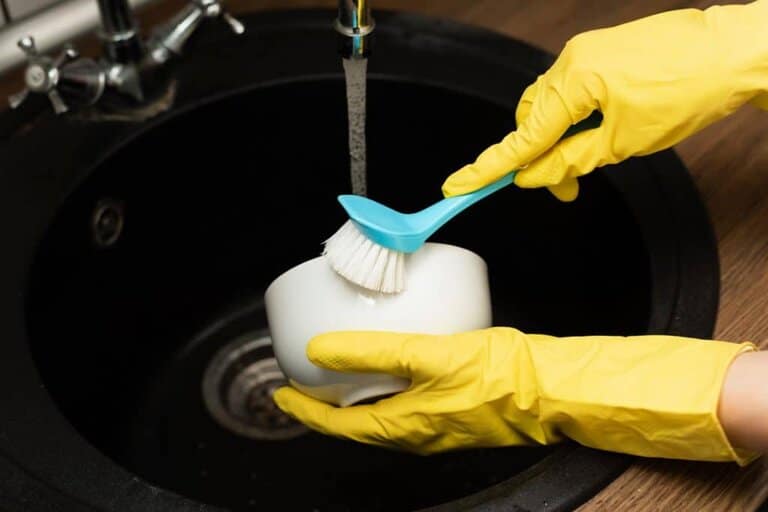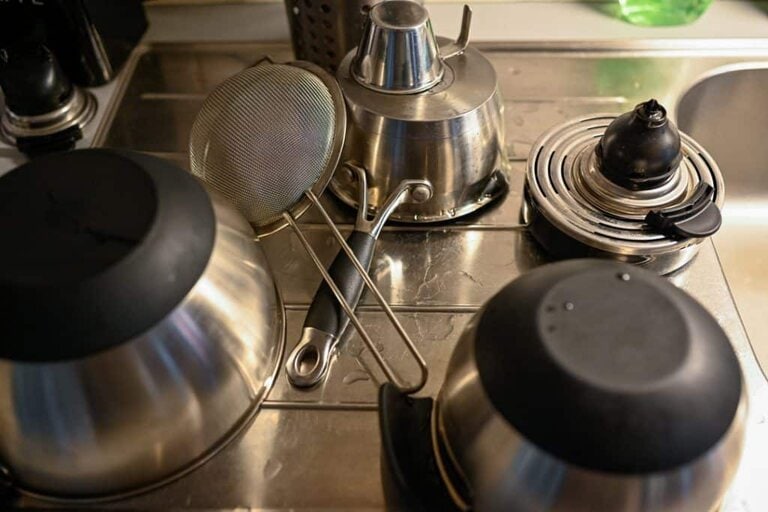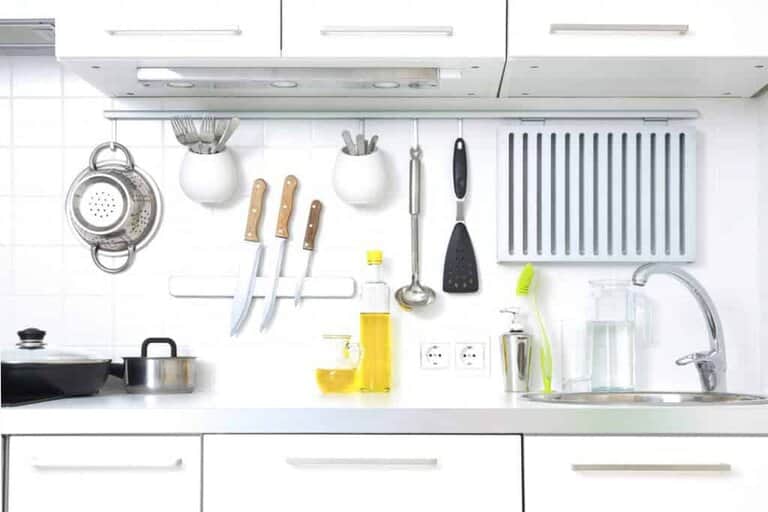First, scrape off the leftover food then wash them in a sink. Next, rinse them out in clean water. You can now sanitize, air dry, and store them. We’ll discuss each step in detail below.

Why Should You Clean Your Utensils?
Kitchen utensils are expected to be kept in the best possible condition. They should be kept safe to prevent damage, away to prevent injuries, and clean to avoid contaminating food items.
The growth of germs and bacteria in the kitchen is not ideal. Disregarding proper cleaning practices in the kitchen may lead to food poisoning and other illnesses, which can sometimes have fatal consequences.
Cooking surfaces and utensils should be cleaned and sanitized regularly. While home-use utensils may be sanitized weekly or monthly, you should sanitize industrial-use utensils at least once every 24 hours.
5 Steps For Sanitizing Utensils

Kitchen utensils are made of a wide range of materials. Some come in copper, stainless steel, iron, plastic, earthenware, glass, clay, etc. Best practices show that these materials should be cleaned differently to maximize use and longevity. The use of strong chemical agents on some materials causes corrosion, leading to leakages. Some other materials are best cleaned with a neat wipe only.
When cleaning and sanitizing, it is important to follow the right process to maximize results. First, prepare the utensils, then clean them before sanitizing and drying.
Prepare for cleaning
This is when dirt and food particles are removed from the utensils. Scrape dirt into a bin and rinse away dirt with running water. Pre-soak the utensils if required. This can be done using a paper towel or spatula. This step helps to arrange utensils in their appropriate categories. It organizes the countertop so all utensils can be cleaned in an orderly manner. When preparing, avoid pouring grease down the drain.
Clean the utensils
Cleaning should be done with a detergent or dishwashing liquid. Fill the drain with hot water (at least 110’F) and scrub with a sponge. Using hot water makes it easy to dislodge tough stains and reduces the time spent scrubbing. Begin with glasses and cups, followed by plates and bowls, then end it with pots and pans. Try keeping the utensils submerged in the lather while scrubbing. Rinse with running water until the dishwashing liquid is completely removed. When using a good dishwashing liquid, there is no need to soak utensils with salt.
Sanitize the utensils
This is the bacteria-killing stage of the process. Sanitizing involves using hot water and a cleaning agent such as bleach on the utensils. The utensils are dipped into the mixture and brushed thoroughly to satisfaction. Soak the utensils inside a bowl of hot water and cover for 5 minutes before removing them.
When using bleach or other agents, leave the utensils to soak in a container filled with the solution. Remove the utensils after a few minutes and rinse thoroughly with hot water.
- When sanitizing iron utensils with rust, wipe with a rust remover or a cloth dipped in oil after cleaning. Use unsalted cooking oil to lather the utensil and subject it to heat for 2 to 3 hours, after which it can be wiped off.
- Copper and brass utensils are best sanitized with a copper/brass polish, vinegar, or salted lemon. Dip a clean piece of cloth into vinegar and wipe till satisfied. It is important to thoroughly wash copper and brass with soapy water to avoid quick tarnishing or corrosion. Avoid soaking or polishing lacquered ornamented copper. Simply wash with soapy water.
- Chopping boards are highly susceptible to enabling secondary contamination within the kitchen. The grooves and cut marks on chopping boards are spaces where the bacteria lodge and multiply. After cleaning with a scrubbing brush and soap to remove stains, soak in a sanitizing solution for about 5 minutes. Cleaning agents that can spray directly will be useful in reaching areas that may not be submerged in the solution.

Air-dry the Utensils.
After sanitization has been done, the utensils are left out to dry. Drying is an important step in this process because bacteria thrive on damp surfaces. Leaving a sanitized utensil damp in enclosed spaces like shelves defeats the purpose of this process. Drying should take place in a well-aired space or under the sun.
Drying under sunlight can be beneficial as it speeds up the process and allows the smell of sanitizing agents to disappear. Drying is to be done with minimal exposure to dust or other contaminants.
Avoid drying wiping with a towel when drying out a sanitized utensil. Using a towel to wipe utensils may re-introduce dirt on them. No matter how clean a wipe looks, they are never really free of microorganisms.
Store the clean and sanitized utensils
After the utensils have been completely dried out, they should be placed in appropriate storage. Cutleries and other dangler utensils should be hung; bowls and other earthenware should be placed inside shelves with doors. Keep cleaned utensils in a sanitized container and keep the boxes clean. Storage is as important as any of the preceding steps.
How To Sanitize With Steam
Steam is an effective means of sanitizing utensils. At the right temperature, steam kills 99% of germs and bacteria on any surface. At temperatures of between 175’F and 212’F, steam will act as a disinfectant. Exposing utensils to at least three minutes of steam at this higher temperature will get the job done.
Steam cleaners are great appliances for applying steam to surfaces and utensils without having to generate steam manually. When water is put into the device, it is heated past its boiling point and forced through a nozzle as pressurized steam. Steam action does not require air drying because steam dissipates instantly. It also avoids scratches and marks on stainless steel utensils. It should be used for utensils that have high heat capacity. There are many great options to select from for steam cleaners.
Sanitizing And Cleaning Tools You’ll Need

Some tools make cleaning easier and more effective. They help clean hard-to-reach areas and perform better than bare hands. Some are designed to clean specific utensils, which reduces time and stress.
Here is a list of important items for cleaning:
Dishwashing liquids or detergents
Dishwashing liquids are used to get rid of dirt and stains on utensils. Dishwashing liquids dissolve in water easily while detergents don’t. This is why dishwashing detergents are usually used with warm water while liquid wash works with cold water.
Gloves
When using chemical agents for sanitization, it is advisable to use a pair of rubber gloves. They protect the hands from the adverse effects of active chemical agents.
Scouring pads
These are efficient cleaners, especially for stainless steel, cast iron pots, and pans. They are strong and durable, which keeps utensils sparkling with minimal effort. They are usually made of steel wool, plastic mesh, or other composite materials.
Deep Clean Brush
These handheld tools get into the cracks of utensils to eject grit and other dried-out materials. They usually come with non-slip grips, which keep them firm during intense action. They are highly durable and can be changed every few months.
Bottlebrush
These are effective in cleaning inside bottles and other hollow utensils. They reach into crevices and dislodge dirt that is hidden from view. Bottle brushes with silicone or nylon bristles do not scratch or scrape the surface of utensils, which makes them desirable. They are also very durable and easy to use.
Difference Between Cleaning and Sanitizing
Many people confuse cleaning and sanitizing, although they are not the same thing. Cleaning is simply removing food particles, drink residue, and other dirt materials from a piece of utensil. On the other hand, Sanitizing involves using a chemical agent to kill germs. The goal of sanitizing is to reduce the number of microorganisms to a safe level. Heat is also a major process in sanitizing because it is one of the most reliable ways to get rid of bacteria. Cleaning agents sometimes have sanitizing capabilities, but they fall short compared to sanitizing agents or heat.
There are different hierarchies of equipment in the kitchen. Utensils that have direct contact with food and those that don’t. All utensils that have contact with food must be sterilized periodically. Utensils include chopping boards, counters, cutleries, glassware, chinaware, pots, pans, and cooking equipment.
Other items that do not have direct contact with food may not need constant sanitization but should be cleaned regularly. Utensils such as racks, holders, and crocks.
The Benefits Of Constant Sanitization of Utensils

- Keeping utensils in a clean state reduces the possibility of food-related illnesses. The germs that cause these illnesses cannot survive on constantly sanitized surfaces.
- Proper cleaning and sanitizing practices increase the life expectancy of your utensils, some of which are quite expensive. Lack of care leads to wear and tear, resulting in unnecessary replacements.
- Cleaning and sanitizing leave your utensils in proper working condition, which reduces injuries. Many injuries result when faulty utensils malfunction.
- Constant cleaning reduces the infestation of pests. Pests are attracted to unclean environments; thus, keeping your kitchen area and utensils clean keep pests at bay.
- A business that keeps utensils clean remains compliant with all safety codes and regulations.
Points To Note About Cleaning and Sanitizing Utensils By Hand
- While some sanitizers are food-safe and not harmful, others are toxic. It is important to read labels for clarifications. Just to be sure, rinse all utensils thoroughly.
- Sanitizers are most effective when diluted correctly. A weak solution renders it ineffective, while a strong one is wasteful and toxic.
- Do not rush the sanitization process. Bleach and other sanitizing agents need time to work. Soaking for a short time renders the process ineffective.
- Before using sanitizing agents, it is important to follow the manufacturer’s instructions for information such as dilution, precautions, storage, contact, etc.
Frequently Asked Questions
Is it enough to wash dishes in a dishwasher?
No, washing dishes in a dishwasher may remove some germs but it might still have harmful microorganisms. However, washing utensils in dishwashers with water of at least 150°F is enough to sanitize them and remove most germs.
Do I need to wash utensils after each use?
Yes, once you pull it out of the rack where it’s been stored, wash your utensils and sanitize them before storing them.
What sanitizers are used for wooden utensils?
You can disinfect wooden utensils in your sink by adding some hydrogen peroxide. Pour sufficient hydrogen peroxide over the utensils and use a spoon to spread it around. It will fizz after a few minutes, and all the germs will be gone.
How long do microbes last on metal utensils?
Viruses can last up to 4 days on average. Depending on the living conditions, they may last up to 9 days. Bacteria can survive on dry metal surfaces for months.
What factors affect the sanitizing process?
You should consider the hardness of the water you are using. Hard water makes it hard for sanitizing agents to work effectively.
Can my dishwasher sanitize utensils?
If your dishwater can produce and maintain a temperature of 150’F. It can be regarded as sanitization.
